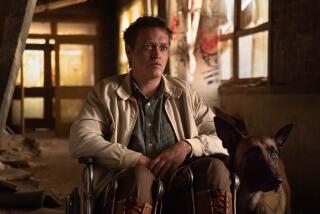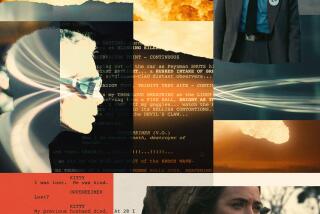‘The Revenant’ stars and director talk being in their element out in the elements
Much has been made of the extreme conditions under which Alejandro G. Iñárritu and his cast and crew worked to film “The Revenant,” the story of frontier scout Hugh Glass, who in 1823 is left for dead by his party after he is horribly mauled by a bear, but who survives and then seeks revenge. It turns out, it was all true. The shoot — through snow, icy water and extreme physical exertion — really was difficult, say the actors Leonardo DiCaprio, Domhnall Gleeson and Forrest Goodluck, who spoke along with their director at a recent Envelope Screening Series Q&A hosted by Times film writer Mark Olsen. Here are excerpts from the conversation.
What was it about this story that made you want to shoot it in this way, with the real locations and the natural light?
Alejandro G. Iñárritu: The fact that it really happened to Hugh Glass in 1823 is very impressive. This is his inspiring true events and the fact that the man is attacked by a creature like a bear like that, and then being abandoned, and then surviving the dead of winter I think it’s a very simple, straight, powerful anecdote to start with and a way to explore many things in a period of time of the United States that hasn’t been explored in cinema in a long time. It was a great opportunity to understand who this guy was, what was the context of that, what made him alive, what can be the driving force of revenge to get you there.
And, Leonardo, what was it about the story that spoke to you?
Leonardo DiCaprio: It was more so being able to work with Alejandro in a film like this. This screenplay I think had been floating around for a while and logistically was very hard to pull off from a cinematic perspective. But there was something in Alejandro’s eyes, in the way he articulated this yearning for wanting to immerse himself in nature. It was more than just doing a movie. He wanted to, by submerging ourselves in the elements like that, extract the poetry of what the story actually was. And that, to me, was the most enlightening and exciting thing about making this movie.
Oscars 2016: Full Coverage | Complete list | Snubs, surprises and reactions | Top nominee photos
And I have to say, it was an endurance test for all of us. It was a very difficult undertaking, but it was incredibly exciting to be a part of a very unique, creative process like this with he and Chivo [cinematographer Emmanuel Lubezki] shooting a film where, you know, we would rehearse all day long intensively and then have this hour and a half of magic light. And all the existential conversations we’d have about man versus nature, you know, the influx of capitalism coming out west from the east, the destruction of our natural resources, what it does to mankind, greed, all these things, really shaped what “Revenant” was, and ultimately informed the ending of this movie. And we kind of knew that by that immersion we would extract something different from what was just on the page, which was a great jumping off point.
And, Domhnall, did you know what you were in for to make this movie?
Domhnall Gleeson: No, is the answer. And Alejandro tried to explain to us what we were in for and even that didn’t explain the full thing because I think maybe it even surprised Alejandro how intense …

Domhnall Gleeson reveals how much he really knew about what he was getting into when he signed on to the movie.
Iñárritu: I did it in a Mexican way I explained myself. In perfect Spanish.
[laughter]
Gleeson: Yeah, I should’ve learned Spanish. I was there for about seven months and I think there’s a cumulative effect of the work kind of breaking you down because of the intensity of the surroundings, but everybody was there because we knew we could do something wonderful. To see Leo do his thing and Alejandro and Tom [Hardy], and everybody else. In my opinion, it may be the best work anyone’s ever done and all of their work is superb already. So the days were very difficult, but it never felt anything less than worth it because all you want is a chance to be in something great and I think this is something great.
Alejandro, Leonardo touched on something that there were only a few hours a day when the light was such that you could actually shoot, but that required many hours of preparation to kind of get every bit of footage you could out of those hours. What was it like to sort of figure out how to make the movie once you were up there?
Iñárritu: Well, we have the great privilege to rehearse months in advance. I started scouting locations for this film five years ago. So we did a huge job of preparing the logistics. Then when Leo and Tom and Domhnall and Will and everybody arrived we start going to the locations physically with a camera and began to shape the thing. So by the time that we arrive to shoot, not only me and them, but every crew member knew what was needed with every detail. Sometimes there was change because the locations collapse. But we rehearsed properly to be prepared for any change. And that is one thing.
The second is that no matter how early we will wake up there’s no way to arrive [before] 11, 12, 1:00 because there were locations two hours away, then the makeup, wardrobe and some scenes of 200 extras. And you can’t shoot at 12 because it’s the [worst] light ever. Right? And then at 3:00 in winter it was dark. So we have to shoot from 1:30 to 2:45. And so it was, in a way, an aesthetical option but it was a technique, a no-brainer, there was no choice. And when you capture the scenes in this hour, the magic hour, the landscapes, the spaces it’s when God speaks and is the ecstasy of nature. Then the film is in ecstasy all the time.
The Envelope Screening Series: ‘The Revenant’

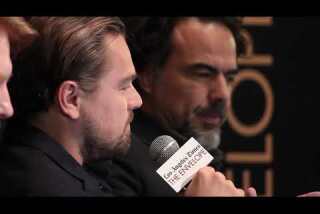
'The Revenant': Attraction of the story
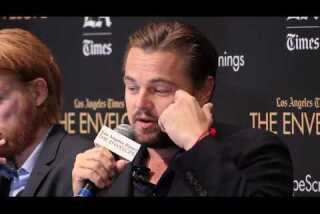
'The Revenant': Conditions affect performance
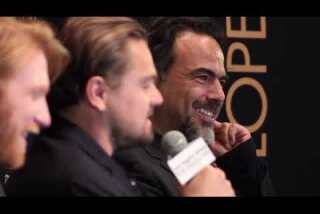
'The Revenant': Agility of the story
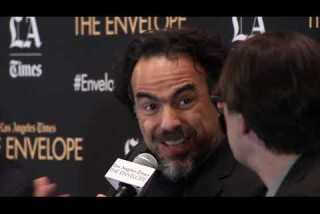
Video: 'The Revenant': Limited shooting hours
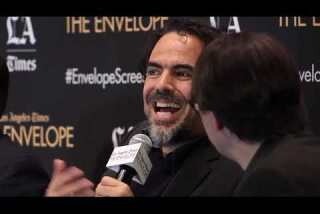
Video: 'The Revenant': The bear scene
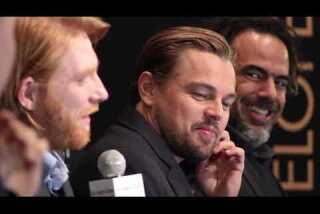
Video: 'The Revenant': Know what you're getting into
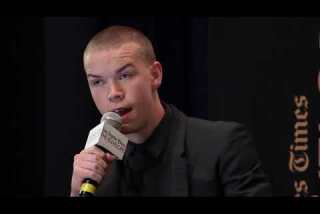
'The Revenant': Knowing a character's future
And now, Forrest, this is your film debut, and this is certainly an unusual project to be starting your career on. What was it like for you as someone who doesn’t have a lot of experience on conventional film sets — did you even realize how unusual it was?
Forrest Goodluck: I’m grateful because I didn’t know what it was to be in a soundstage or, like, a 72-degree room. So, I mean, I don’t know; it wasn’t too bad, honestly. This is as bad as it gets, Alejandro.
Leonardo, do you think you could’ve given this performance in a more conventional setting?
DiCaprio: Oh, most certainly we had to be on these locations, not only for the beauty that nature gave us, but I think the savagery as well. I think the adaptability that we needed to have as an entire production was tremendous. I mean, we would come into sets one day that was filled with six feet of snow and that would just evaporate in one night and we’d be left with a prairie for two solid weeks, so we had to invent other stuff to shoot. Or we’d have another scenario where there would be a river flowing through and all of a sudden a storm would come through and the entire landscape was a frozen icicle. All the things that nature gave us and provided us are up there on screen, things that we could have never predicted. My last day on set was insane. We had an aurora borealis up at the top of this peak of this mountain and we were doing that last bit of dialogue, and I was set to go home, and then Chivo and Alejandro go, “Look, an aurora borealis,” and they went and grabbed wine and shot there for the next three hours, you know.
Iñárritu: I bet that none of you have got drunk with an aurora borealis.
[laughter]
Iñárritu: But, honestly, it was true. I said, “Cut,” and that was the last day of Leo. We were on Fort Lewis Mountain and there was an aurora borealis. So I don’t know if somebody was like, “OK, bye, Leo.”
[laughter]
Now I have to ask about the bear sequence. And I know that you like to sort of keep the rabbit in the hat to some extent as far as what kind of the magic of how you do these things, but can you give us some sense of what went into it?

Director Alejandro G. Iñárritu reveals as much as he can about creating the brutal bear attack scene without giving away exactly how they pulled it off.
DiCaprio: Let me start off by first saying that he watched over a hundred different clips of bear attacks before he started the sequence.
Iñárritu: I became very gory after that. No, it’s true, the research of how it happened is very important because, you know, all the Hollywood films are like the bear, they are bad guys, right? All the animals in Hollywood have human emotions. I hate that. I don’t know if you saw “Grizzly Man” with Werner Herzog, but when he’s with the headphones hearing what happened I always wanted to know what he heard, and I asked Werner. And he said, “Alejandro, I can’t describe it. I can’t describe what I heard. It will be so disturbing for audiences.” But he explained to me a couple of things that I was very surprised about it, and then I interviewed a guy in Montana who has written a book interviewing people that have survived or witnessed bear attacks. And he was the one who told me the last sound that one guy will hear in his life is that kind of cow little thing [makes animal sound]. That’s the last thing that you will hear. So if you are in the forest and hear that, bye-bye, because that means that you will cross into a bear and her cub.
And then we spent time finding what the point of view will be best — to shoot this in a way that it’s kind of a National Geographic or a horrifying document from a Japanese guy in a park seeing something. But at the same time with the possibility that you all can be experiencing what Leo was experiencing, what Hugh Glass was experiencing. So Chivo and I did a lot of things to understand what was the best. And then once we have an idea then we start talking with Leo and Leo was saying, “What about if I do this,” and yada yada. The pace that Leo got it informed all the camera movements, like all that cracking bone and that heaviness, which, you know, you never envision as a director, but when you see somebody really getting there. And then Leo suggests, for example, the hand thing, you know, which I think is genius because he said, “What if I try to grab him and then the hand was just horrifying?” So we were in a way discovering beat by beat together what was best. You are basically storyboarding but with human beings. Once we finished the choreography, then I will not tell you.
Leonardo, were you surprised the first time that you saw the finished sequence?
DiCaprio: Yes, absolutely. And I think what Alejandro touched upon there, but didn’t expand upon, was what’s so chilling about that is the moments of silence for me, you know, the tension that you feel as an audience member not knowing what the hell’s going to happen next. And to me why this sequence is so talked about by everybody, seemingly, is because it is quite revolutionary. We’ve seen so many action sequences before, but there’s a weightlessness to it. This has a heaviness to it. This is a type of reality that I’ve never seen before in certainly a man-versus-beast interaction or a fight of this magnitude. And the fact that he and Chivo achieved this thing where it almost feels like virtual reality at times where you feel voyeuristic like you shouldn’t be watching the intimacy of these moments, the bear’s breath, the sweat, the blood. It almost awakens other senses in you as an audience, you know. Being able to watch it for the first time, it was so visceral, so tactile. And it’s one of those sequences that I think will go down in cinema history because you’re literally on the edge of your seat. And he gave such life to this animal, this beast, all of these creatures here including myself, all the characters, everyone’s just trying to survive, so is this animal.
I want to be sure to ask about that opening battle sequence, Domhnall, how genuinely chaotic was that scene?
Gleeson: I think it was ordered chaos. It took a long time for everybody to learn the steps. You know, if you’re dancing with somebody and you’re only learning the dance you can’t really talk at the same time. We all have to learn the steps and really, really know them before we could get to the place where you could express yourself at the same time. And so it was really, really wet and it was really, really cold and it was really, really difficult. There was a lot of stuff going on with horses and stuntmen and fires and guns, and all the rest of it. And then once you get past all that and you get to the place where you can start acting in the middle of it, it began to feel amazing. We shot chronologically though, so we know that it’s just going to get worse. It’s going to get colder.
Forrest, what was your perspective on that opening scene?
Goodluck: The first shot I’d ever done in the film, I had to run through that scene — my first take on a feature film ever. I run across, hit like some mud and then just face plant. I told Alejandro that he had baptized me into the film industry at that moment.
Alejandro, one of the big changes in the film from the book that it’s probably based on is sort of the attention that you give to native peoples, the sort of addition that you give to Hugh as far as his wife and his son. Can you talk a little bit about making those additions to the story?
Iñárritu: There’s a lot that has been talked about the way we did it and the physicality of it. But there’s a lot [more] to be discovered in this film. There’s a lot of layers that you can read and, obviously, the heart of it is this relation of Hugh Glass and Hawk. The conflict of the father carrying a mixed race kid in those times where so much prejudice was about irrational thinking, which are no different from today, which was something that I really was very interested to explore: what it meant to be a mixed race kid in that time as today. And then the way that the Native Americans were presented was a huge thing that I wanted to really integrate well because that has been so interpreted, you know, they are the savages and the bad people or they are sanctified and they are pure and great. And I hate that because they are as complex and as contradictory as any human being.
The Arikara warrior, he’s looking for his daughter and in that dimension of a father looking for … there’s no cultural differences. So I want to give the same kind of power and dignity and clarity in that sense. And the social context, how these trappers were literally, completely exploited and how these people killed so much animals and extract the nature and impact so much pain in nature, in animals, in communities is very resonant today. We keep doing the same and that was the planted seed of the global warming that now is the harvest of what we planted 200 years ago.
ALSO
James Corden to host Tony Awards — but can he reverse ratings slide?
South by Southwest film program announced; festival runs March 11-19
‘Spotlight,’ ‘Big Short’ and ‘Revenant’ may be strongest contenders for best picture Oscar
More to Read
From the Oscars to the Emmys.
Get the Envelope newsletter for exclusive awards season coverage, behind-the-scenes stories from the Envelope podcast and columnist Glenn Whipp’s must-read analysis.
You may occasionally receive promotional content from the Los Angeles Times.
